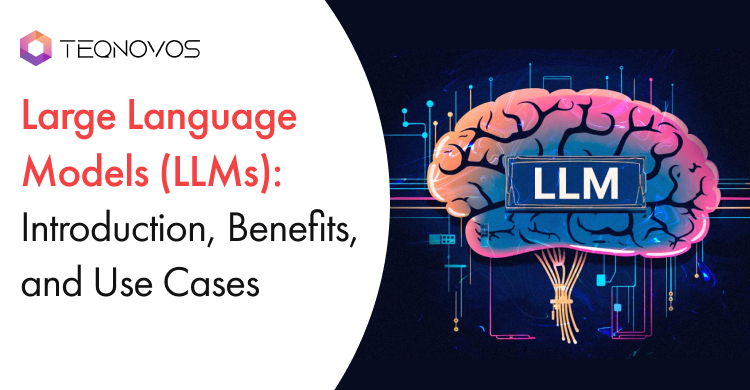Large Language Models (LLMs): Introduction, Benefits, and Use Cases
In the ever-evolving artificial intelligence industry, large language models (LLMs) have taken center stage, being the ultimate driving force. These are powerful AI models with deep learning algorithms that forge a connection between humans and machine technologies.
Currently, several businesses across industries are opting for LLM software development services to build their custom large language model applications. However, amidst all the hype and excitement, many businesses are still confused about large language models and what they do.
Therefore, in this blog, we will talk all about LLMs, including what they are, their main benefits, and their use cases. So, what are you waiting for? Step into the world of large language models with us now!
What is a Large Language Model (LLM)?
A large language model is a machine learning model that is designed with enhanced capabilities to perform natural language processing tasks. LLMs use transformer models and are trained on large datasets from different sources. This allows them to comprehend inputs and generate natural responses.
These innovative models are also referred to as neural networks, which leverage deep learning techniques to produce relevant content. This is why LLMs are also the foundation of natural language processing, which is a merger between computer science and linguistics.
Some of the key components of large language model applications include transformers, training data, parameter training, etc. These are essential to ensuring the smooth working of LLMs accurately.
The Working of Large Language Models
Speaking of the workings of large language models, here’s what you need to know about their functioning: LLMs receive inputs known as tokens from users in human language, which they convert into machine language to comprehend the message. The model then explores its datasets to find pertinent information.
Once the information is received, the model will put together the response for the users. Then, the information is converted back into the language in which the request was made. Remember that large language models need to be updated with new datasets to ensure data accuracy over time.
Understanding the Benefits of Large Language Models
The hype around LLMs is mainly due to their ability to offer assistance with a wide range of things within a business. Besides, with time, large language models AI has improved at replicating human practices and performing certain tasks seamlessly.
Here are some of the main benefits of LLMs that you should know about before you go ahead with LLM software development.
1. Advanced Process Automation
A large language model’s first and perhaps most important benefit is its advanced automation capabilities. This not only helps businesses perform different tasks quickly but also saves a great deal of money on hiring resources. Generative AI is a prime example of LLM offering top-notch automation assistance.
From generating different types of business content as required to handling customer queries and offering data insights, LLM can do it all. These are some of the key business operations that often consume a lot of time in bits and pieces. Thanks to LLM, you can now automate these tasks and free yourself up.
2. Increased Accuracy in Routine Tasks
Since large language models are trained on extensive datasets, they have a vast amount of data as references. This automatically leads to improved accuracy in anticipation of the user’s expectations and eventually precise outcomes. So, you can count on LLMs to bring accuracy to everyday tasks.
Whereas, your hired professionals, no matter how experienced, might not be able to maintain accuracy in tasks day in and day out. Therefore, you should put an LLM-based application in place to take over different essential business processes, such as content generation.
3. Enhanced Personalization
Personalization of services is essential for modern businesses to stand out from their competitors. Fortunately, companies using large language models can benefit from their potential to provide personalized suggestions to users. LLMs evaluate user data to understand their interests.
This is a great feature to have in your custom large language model, as it helps you connect with your customers. E-commerce enterprises can benefit from LLM’s personalized assistance to offer product recommendations and shopping suggestions to customers based on their unique preferences.
4. Improved Scalability
Large language models have great scalability, which makes them the best choice of AI for the current marketplace. In today’s dynamic business world, you need technology that can cope with changing trends and increasing demands comprehensively. LLMs can self-improve, making them highly scalable.
LLM-based tools and software are built in such a way that they self-improve with each task they perform by learning from users’ requests. Further, since these are intelligent AI models, they can handle large volumes of data easily and adapt according to changing user demands.
Exploring the Major Use Cases of Large Language Models
LLM applications are used across businesses for several purposes nowadays. So, if you are planning to opt for LLM software development, you must learn about these purposes beforehand. Doing so will allow you to make the most of this latest AI technology to benefit your business.
Check out the four most prominent use cases of large language models below and leverage the power of large language model applications.
1. Content Creation
Large language models are capable of producing human-like text as per the user’s unique requirements. From generating blogs, articles, and captions to drafting emails, an LLM app can do it all. So, by using an LLM-based content generator, you can meet your business’s content requirements quickly and efficiently.
Building a full-fledged team of writers to brainstorm new ideas and write error-free content can be a daunting task. Besides, human-generated blogs will always have a higher chance of making mistakes. So, you can rely on the AI tool to not only write content instantly but also avoid basic human errors.
2. Chatbots and Customer Service
Customer service is also a common use case of LLMs. Since these models can understand inputs in human language and produce responses, they are actively used in customer service. Various big and small enterprises are using intelligent AI chatbots for customer support.
These chatbots can offer 24/7 assistance to customers. For businesses, investing in a chatbot can prove beneficial in saving money and improving the customer experience in the long run. If you want to build a custom chatbot, just reach out to an AI chatbot development company.
3. Software Code Generation
Software development services are in high demand as companies across the globe are looking to build custom software. However, any software developer would agree that writing codes for unique software can be a time-consuming affair. Thanks to LLM, they don’t have to write codes from scratch anymore.
There are modern LLM AI apps that are used to generate code snippets, making software coding easier. Whether you are writing codes in Python or any other language, just add prompts to the LLM tool, and it will assist you with the rest of the process.
4. Data Analysis
Large language models allow businesses to accurately analyze customers’ data, which eventually helps them predict their preferences. Based on a particular customer’s previous purchases, the LLM software educates a brand on their likes and dislikes. This information helps brands personalize their services.
Suggesting products to customers based on their interests leads to a higher chance of them going through with the purchase. Moreover, effective data analysis also assists brands in predicting upcoming trends in the market and preparing accordingly.
Wrapping Up
Large language models are arguably one of the top AI innovations that are transforming businesses by enhancing machine capabilities. Therefore, as a business owner, there are many benefits to custom LLM software development that you must know about. But before that, you should first know about LLM itself.
LLM is a language-specific AI model that can generate high-quality responses to user inputs within seconds. However, the benefits and use cases of an LLM application go beyond that. In this blog, we have discussed everything about LLM, including these great benefits and use cases for you to go through.
As soon as you familiarize yourself with the basics of large language models, reach out to us at Teqnovos. We are an LLM software development company with a team of highly skilled and experienced AI developers. Our professionals can build your custom LLM software exactly as your business demands.
Frequently Asked Questions
1. What is the difference between LLMs and generative AI?
Generative AI and large language models are two major concepts in the field of artificial intelligence. Although both of these models are used for process automation, they focus on different aspects of artificial intelligence. LLMs specialize in understanding human languages accurately and generating relevant responses. Whereas generative AI covers a wider scope of AI automation, including text, image, audio, and video generation. Both generative AI and LLM are important for businesses to understand if they are looking to build custom AI software.
2. What are the benefits of large language models?
There are many benefits to LLMs that many businesses can reap. For example, large language models are available 24/7, which lets companies use them for different purposes anytime, anywhere. Further, an LLM can automate several routine processes and accomplish them accurately. You can use a custom LLM application for content generation, customer service, and more. Lastly, large language models can also understand users’ data patterns to understand their preferences and personalize responses to fulfill their requirements. These are a few of the many great benefits of using large language models.
3. What are the common risks of large-language models?
Just like any emerging technology, large language models come with their share of risks. One of the most common risks that it possesses is bias in content. Since these models take information from existing datasets, they might form opinions around any topic based on a biased piece of content. This is a concern since these models are not yet trained to eliminate biases from any information while contemplating results. Apart from this, the accuracy of content is also at risk if an LLM application receives data from an inaccurate source.
4. How can companies use large language models?
Large language models have many amazing use cases for modern companies. The number one is their ability to generate different types of content for a company. From captions to blogs and emails, LLM applications can write them all. Apart from this, they are also used by software developers to automate code generation and speed up the development process. However, arguably the most successful use of LLM has been in AI chatbots that have helped companies enhance customer service, leading to better customer satisfaction.
















